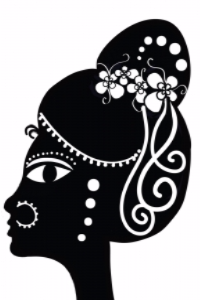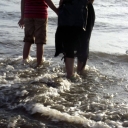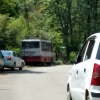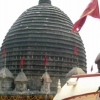
Visit to Kamakhya Temple – Decoding the Tantra Connect
According to the legend, Daksha once organised a grand yagna to which all Gods were invited with the exception of Sati and Lord Shiva. Sati on knowing about the yagna, wanted to visit her father Daksha’s home. Lord Shiva tried to dissuade her, but then allowed her to visit her father’s place and asked his ganas to accompany her. When Sati reached her father’s home, he insulted her and her husband Lord Shiva. Deeply hurt and insulted Sati cursed her father to die at Lord Shiva’s hand, after which, she invoked her yogic powers and immolated herself in the yogic agni (fire). On knowing about Sati’s death, Lord Shiva who loved Sati more than anything got very angry. He danced the terrible Rudratandava – a dance of destruction- in his rage and pulled a lock of hair, throwing it on the ground from which arose Virbhadra and Bhadrakali, who on Lord Shiva’s order wrecked havoc and mayhem at Daksha’s place. Virbhadra killed Daksha by cutting his head, which fell in the burning yagna. Lord Shiva lifted Sati’s burnt body on his shoulder and aimlessly wandered about the world crazed in grief. The Gods called upon Lord Vishnu to restore Lord Shiva to normalcy. Using his sudarshan chakra, Lord Vishnu dismembered the dead body of Sati in 51 pieces which fell on earth at various places. Places where body parts of Sati fell are called Shakti peeths and have great significance for the Hindus, especially for the worshippers/followers/practitioners of Tantra.
Kamakhya temple denotes the spot where Sati’s yoni fell. It is the most important centre for Tantra worshippers/followers. The entire structure is a complex, consisting of the main temple area and temple of ten Mahavidyas in and around the main temple area. These include the temples of Bhuvaneshvari, Baglamukhi, Chinnamasta, Tripura Sundari, Tara, Kali, Bhairavi, Dhumvati, Matangi and Kamla. Among these, temples of Tripura Sundari, Matangi and Kamala are inside the main temple area and other seven are individual temples located on Nilachal hills. There is a map of the same close to the entrance which shows the locations of these temples.
History of the temple
The first epigraphic notice of Kamakhya is found in the 9th century Tezpur plates of Vanamalavarmadeva of the Mlechchha dynasty. There is enough archaeological evidence to suggest a massive 8th-9th century temple. It was earlier believed that the temple was destroyed by Kalapahar, a general of Sulaiman Karrani (1566–1572), though latest historical findings favour instead an earlier destruction that happened during Hussein Shah’s invasion of the Kamata kingdom (1498), then under Nilambar. The ruins of the temple was said to have been discovered by Vishwasingha, the founder of the Koch dynasty, who revived worship at the site; but it was during the reign of his son, Naranarayan, that the temple reconstruction was completed in 1565. The reconstruction used material from the original temples that was lying scattered about. Banerji (1925) records that this structure was further built over by the rulers of the Ahom kingdom. Many other structures were later additions.
Without the support of the Koch royal family the temple faced lot of hardship. By the end of 1658, the Ahoms under king Jayadhvaj Singha had conquered the Lower Assam and their interests in the temple grew. In the decades that followed the Ahom kings, all who were either devout Shaivite or Shakta continued to support the temple by rebuilding and renovating it. Rudra Singha (reign 1696 to 1714) was a devout Hindu and as he grew older he decided to formally embrace the religion and become an orthodox Hindu by being initiated or taking sharan of a Guru, who would teach him the mantras and become his spiritual guide. But, he could not bear the thought of humbling himself in front of a Brahmin who is his subject. He therefore sent envoys to Bengal and summoned Krishnaram Bhattacharyya, a famous mahant of Shakta sect who lived in Malipota, near Santipur in Nadia district. The mahant was unwilling to come, but consented on being promised to be given the care of the Kamakhya temple to him. Though the king did not take sharan, he satisfied the mahant by ordering his sons and the Brahmins in his entourage to accept him as their spiritual guru.
When Rudra Singha died, his eldest son Siba Singha (reign 1714 to 1744), who became the king, gave the management of the Kamakhya temple and along with it large areas of land (Debottar land) to Mahant Krishnaram Bhattacharyya. The Mahant and his successors came to be known as Parbatiya Gosains, as they resided on top of the Nilachal hill. Many Kamakhya priests and modern Saktas of Assam are either disciples or descendants of the Parbatiya Gosains, or of the Nati and Na Gosains.
Location and how to reach
The temple is located on the Nilachal Hills in the western part of Guwahati (Kamrup District) on the adjoining banks of Brahamputra river. It is a Hindu temple dedicated to the mother goddess Kamakhya and is considered the most sacred and oldest of the 51 Shakti Peethas.
It is around 7.5 kms from Guwahati Railway station, 5.5 kms from Kamakhya Railway station and 20 kms from Guwahati international airport.
Auto Rickshaws, Taxis, Buses etc. are easily available from every part of Guwahati. One can also visit the temple by foot.
Architecture of the temple
The temple consists of four chambers: garbhagriha and three mandapas locally called calanta, pancaratna and natamandira.
The garbhagriha has pancharathaplan and rests on plinth moldings that are similar to the Surya Temple at Tezpur, above which are dados from a later period of the Khajuraho or the Central Indian type, consisting of sunken panels alternating with pilasters. The sikhara is in the shape of a beehive, which is characteristic of temples in Lower Assam. The panels have delightfully sculptured Ganesha and other Hindu gods and goddesses. Though the lower portion is of stone, the shikhara in the shape of a polygonal beehive- dome is made of brick, which is characteristic of temples in Kamrup. The shikhara is circled by a number of minaret inspired angashikharas of Bengal type charchala. The Shikhara, angashikharas and other chambers were built in the 16th century and after. The inner sanctum, the garbhagriha, is a cave below ground level and consists of no image but a rock fissure: The garbhagriha is small and dark, and reached by narrow steep stone steps. Inside the cave there is a sheet of stone that slopes downwards from both sides meeting in a yoni-like depression some 10 inches deep. This hallow is constantly filled with water from an underground perennial spring. It is the vulva-shaped depression that is worshiped as the goddess Kamakhya herself and considered as the most important pitha (abode) of the Devi.
The temple consists of three additional chambers. The first in the west is the calanta, a square chamber of type atchala (similar to the 1659 Radha-Vinod Temple of Bishnupur). The entrance to the temple is generally via its northern door that is of Ahom type dochala. It houses a small movable idol of the Goddess, a later addition, which explains the name. The walls of this chamber contain sculpted images of Naranarayana, related inscriptions and other gods. It leads into the garbhagriha via descending steps. The pancharatna to the west of calanta is large and rectangular with a flat roof and five smaller shikharas of the same style as the main skhikara. The middle shikhara is slightly bigger than the other four. The natamandira extends to the west of the pancharatna with an apsidal end and ridged roof of the Ranghar type Ahom style. It’s inside walls bear inscriptions from Rajeswar Singha (1759) and Gaurinath Singha (1782), which indicate the period this structure was built.
The middle chamber leads to the sanctum sanctorum of the temple in the form of a cave, which consists of no image but a natural underground spring that flows through a yoni-shaped cleft in the bedrock.
The Ambubachi Mela
The Ambubachi Mela is one of the most important festivals of the Kamakhya temple. This yearly mela is celebrated during the monsoon season that happens to fall during the Assamese month of Ahaar, around the middle of June when sun transits to the zodiac Mithuna, and the Brahmaputra river is in spate. It is believed that Devi Kamakhya, the presiding goddess, goes through her annual cycle of menstruation during this period. It is also believed that during the monsoon rains the creative and nurturing power of the 'menses' of Mother Earth becomes accessible to devotees at this site during the mela.
During the Ambubachi Mela, the doors of the Kamakhya temple remain closed for three days. During these three days some restrictions are observed by the devotees, like not performing puja, no ploughing and other farming activities or reading books etc. After three days, once the ritual bathing of Devi Kamakhya and performing other rituals associated with it are completed, the doors of the temple are reopened and devotees are allowed inside to worship the goddess and prasad is distributed. The prasad consists of a blood-red strip of wet, believed to be soaked in the menstruating blood of the goddess. Lakhs of pilgrims visit the temple during this mela. Another interesting fact associated with the Ambubachi Mela is that during this time the Brahamputra river flowing near the temple mysteriously turns red and then becomes normal post the mela period.
Our Visit
We visited the temple during Navratri in the month of March, as a part of our visit to Guwahati. We had initially planned a visit to Guwahati, but then had cancelled the same and had decided to visit Gangtok. But somehow at the time of finalising the trip, we ended up visiting Guwahati. (For very religious – it was as if the goddess Kamakhya wanted us to visit her abode; for the logical – it was very cold in Gangtok and with a small kid we didn’t want to travel and expose him to extreme weather in the north east).
On our way to our hotel in Gwahati from the airport, we saw the signage saying Kamakhya temple and the way to the temple complex. As mentioned earlier, it is located on Nilanchal hills. The railway line also moves close to this road (Assam Trunk Road – Chaayagaon – Guwahati road). We decided that the next morning we would visit the same and then tour a couple of other places in the city (without realising that something else was in store for us).
The staff at the property where we were staying (Baruah Bhawan – a heritage house of one of the biggest tea estate owners in this region and a very renowned family in Guwahati, converted into a five star home stay option – not exactly home stay but more like a boutique property) suggested that we should take a radio taxi which would be more convenient and cheaper. We agreed and didn’t regret our decision, the radio taxis are decent, but please don’t seek any advice (they are not tourist friendly – in fact the whole city is like that). The drive to Kamakhya complex was pleasant, especially the ride up the curvaceous road on the Nilanchal hill. The taxi and all other vehicles would drop you at the parking spot. From here we had to walk almost 500 meters to reach the main complex. On both sides of the lane to the main complex, there were small shops selling handicraft items, pooja offerings and also prasad. The shop keepers tempt you with stories that you would not get all this stuff ahead and they would request you to deposit your shoes, bags and other leather items. Whether you want to be tempted or move ahead and explore is your choice. There are many Dharamshalas here, where one can find cheap stay options. The Temple trust has locker areas where you can deposit your shoes but doesn’t inform if you could deposit other items also. This is close to the temple trust’s dharamshala. We deposited our shoes here and then climbed up. The climb is not tedious at all, on the way we saw some blind singers singing devotional songs in Assamese and Bengali, the songs thankfully still had the folk feel. Just close to the temple gates, we were once again informed that we need to deposit our bags (including ladies purses), and other leather items (unfortunately the temple trust doesn’t have any facilities here and you would have to use the services of the small shopkeepers who sell pooja samigri and prashad). We were allowed to take our mobile phones and camera. We bought the pooja samigri and prasad and entered the temple through the heavily guarded main gate (similar to one at Kashi Vishwanath). An interesting thing that we noticed close to the main gate was the presence of goats in abundance and kids selling pigeons. These were the sacrificial animals. Once inside the complex we were met with the same sight. The temple complex was beautifully decorated using a lot of banana leaves, marigold, hibiscus and rose flowers. The temple complex was crowded and unlike many other temples where there is proper crowd management, here there were no signs of crowd management. Goats roamed around freely dropping those black beads everywhere. The children selling pigeons were more persuasive, some even trying to frighten you into buying those pigeons out by dishing out some terrifying stories. We saw a lot of ‘pandas’, similar to pandas in Kashi Vishwanath and other temples, the only difference was they were not as persuasive as their counterparts in the other temples.
So many people, but no one to guide you where to go. We finally decided to take help from the army men who were also part of the security team. They gave us the directions and also informed that we can buy pass for VIP line (@ Rs. 500 per person – children below 12 years free), as this would help us complete our darshan faster. In the normal line people were standing since 4.00 am in the morning and on an average, due to Navratri, it would take around 4-5 hours for the darshan. We bought the VIP line tickets. Please don’t expect any special privileges in terms of the infrastructure for VIP line. Everything was the same; the temple trust has divided the narrow way in two parts, the normal and VIP. The difference was – in the normal line area, people were standing like sardines stuffed in a can and in the VIP line you had breathing and moving space. The devotees need to move through a special passage (which in normal days is very short and direct) to reach the main complex: the complex which has the girbhgriha during any special festivals. This is a narrow serpentine passage where you go up and down the narrow stairs. There was a place where we saw three buffalo calves tethered, waiting to be sacrificed (in fact we saw the Pujaris carrying the bleeding head of one of the calf we had seen, later in the complex).
The VIP line moved faster in comparison to the normal line. The last phase of this narrow serpentine passage was a small hall, which was very crowded due to the lack of space (two lines divided by iron grills). It was claustrophobic here; it felt like we were cooped up like chickens in a coop. Again there was no one to manage crowds, an army man was accompanying his family, and was helping manage the crowd in the VIP line. Finally after around two and a half hour we could finally enter the main complex area. During normal days one would enter this area via its northern door. This area houses a small movable idol of the Goddess. The walls of this chamber contain sculpted images of Naranarayana, related inscriptions and other gods and goddesses. We were moving in a circular fashion around the movable idol and the pujaris were mainly focusing on the devotees who were with the Pandas, while the rest were being rushed. The chamber was decently lit and we could see images of Naranarayana and various gods and goddesses (mainly forms of Durga or Goddess Shakti), at the larger images the pujari stationed there was applying tikka (sindoor) and asking for some dakshina or daan. The idol of goddess in the centre was covered with brightly decorated clothes and flowers. At the base of the idol there were offerings in the form of fruits, vegetables and yes, next to all these offerings – the primary offering was lying – head of the buffalo calf. (No we were not repulsed by the sight, nor were we terrified – the sight was only different compared to many other temples)
From here the line moved into the Girbhgriha (an underground cave like area) via old stone steps. There were no lights in the Girbhgriha and we were literally being pushed forward with warnings like ‘Beware, there are steps ahead). There is no image here, what we could see in the light of a single diya (earthen lamp) was an area covered with decorated red cloth and offerings of hibiscus flowers. The pujaris in this area were asking people to touch the covered area and seek the divine blessings. When I bowed and touched the area, I realised that water was flowing in from that area (it’s the natural underground spring that flows through a yoni-shaped cleft in the bedrock). The pujari hurriedly applied the sindoor and we were asked to move back (our return journey). As the path is narrow, the pushing and shoving continued (mainly because of devotees who in their fervour and eagerness to seek the divine blessings, forget basic courtesies), a lady who was on the bulkier side kept on pressing my son, so much so that we had to finally intervene by speaking out loud to move and that there was a kid with us. Once again the stairs brought us to the central chamber from where we were directed to move out through the Northern door.
The crowd in the complex grounds had swelled many folds from the time we had arrived. After some quick photographs (yes, except inside the central chamber and girbhgriha, photography is allowed) which would always be a part of a memorable trip, we decided to move out of the complex area. We called the radio taxi and thankfully were informed that it would be there at the parking area in 15 minutes.
After collecting our shoes and other stuff, we reached the parking area, dead tired. The taxi was there which dropped us back to our accommodation. We were dead tired and hungry, all the previously made plans were dropped; we had our meals at the Dosa Plaza which was close to Baruha Bhawan and then decided to rest for the day and continue with exploring the city for the evening and the next day.
Overall the trip to the temple was a memorable one. Though there were times when we felt that the experience of the devotees could be increased many folds by proper management. We had heard a lot of myths about the temple and the tantric practices of the temple. So much so that a senior family member who is a geologist tried to dissuade us from the visit by saying that, “Wahan toh narbali di jaati hai”, (human sacrifice is practiced there), and that we should avoid this temple at all cost. Thankfully we went with an open mind and the practices at the temple didn’t terrify us, instead we came back spiritually enlightened and amazed with the diversity our culture has.
References :
http://www.templenet.com/Assam/kamakhya.html
https://archive.org/details/annualreportofth030750mbp
http://jhs.oxfordjournals.org/content/4/3/231.full.pdf+html
http://www.tandfonline.com/doi/pdf/10.1080/00856400802441946
http://www.indianholiday.com/fairs-and-festivals/assam/ambubachi-mela.html
About the Author




Comments